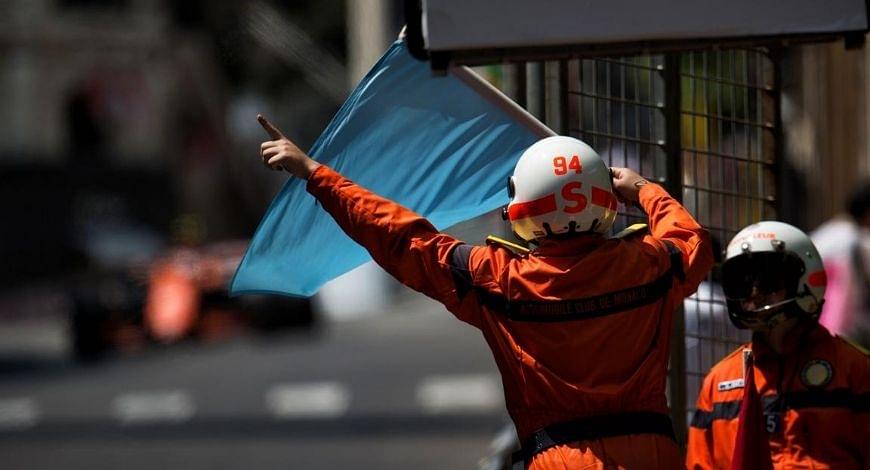Blue Flag F1: What is the significance of the Blue flag in F1 and when it is used? The Sportsrus explains the purpose behind this flag.
A Formula 1 track is full of flags, instructing the driver how to act for a specific moment or giving a heads up for hindrances ahead on the track, flags are imperative to Formula 1.
Learning about Formula 1 flags is the foremost important thing in motorsport racing and every aspiring young racer learns about in the initial stages of their career.
To know the relevance of each flag is as important to a veteran racer as it is to a novice. The Sportsrush will explain the significance of a Blue flag in Formula 1.
The Blue flags are probably the most used flag during the Grand Prix weekend. And probably it is the most heartbreaking sight for any driver.
What’s the use of a Blue Flag in F1?
As per the rules, the blue flag is shown to a driver to indicate that a faster car is behind him and trying to overtake. Shown both lapped cars and those racing.
A lapped car must allow the faster car past after seeing a maximum of three blue flags or risk being penalised. A racing car is under no obligation to move over.
The FIA puts the blue flag in the action when the faster car is just 1.2 seconds behind the car it intends to lap during the race.
Where are the blue flags mostly used?
The blue flags’ nature makes them prone to appear on the tracks which are shorter. Thus, it is easier for the faster cars to lap the inferior cars. So, it is easy for cars to see blue flags on circuits like Monaco, Mexico City, Sao Paolo or even Speilberg, where the length of the tracks is short.
Meanwhile, the drivers’ abilities also determine the number of blue flags. Nikita Mazepin in 2021 was approximately lapped 228 times in a span of 22 races.
Controversies over the blue flag in F1
This 1.2-second rule has been frustrating for the drivers during the races where the lanes are narrow and overtaking is tough or has good straights.
Valtteri Bottas in 2018 showed his frustration against the rule during Singapore GP. He shouted over the radio that such a gap was too big for a track like Singapore.
On the other hand, Lewis Hamilton was losing time because of battling Romain Grosjean and Sergey Sirotkin, which almost made him caught by pursuer Max Verstappen.
However, F1 immediately defended it by saying that any alterations to it would be unfair to slower cars, hence the mentioned time frame is justified.
“This time last year it was one second, and we had discussions, and we opened it up to 1.2s,” said Charles Whitling to Autosport, Race director back in 2018.
“I don’t think we should go any more than that, because then you get into a situation where a driver has to back off and lose a lot more time than he really should to let the other car through if he’s got to do it at his earliest opportunity.
“If we say, when he’s 1.4s or 1.6s behind, you’ve got to move right over, back off, and lose a lot of time, we don’t want that to happen because it’s not fair.”
Also read: F1 2020 Calendar: Reason why 2020 Imola Grand Prix is only for two days



